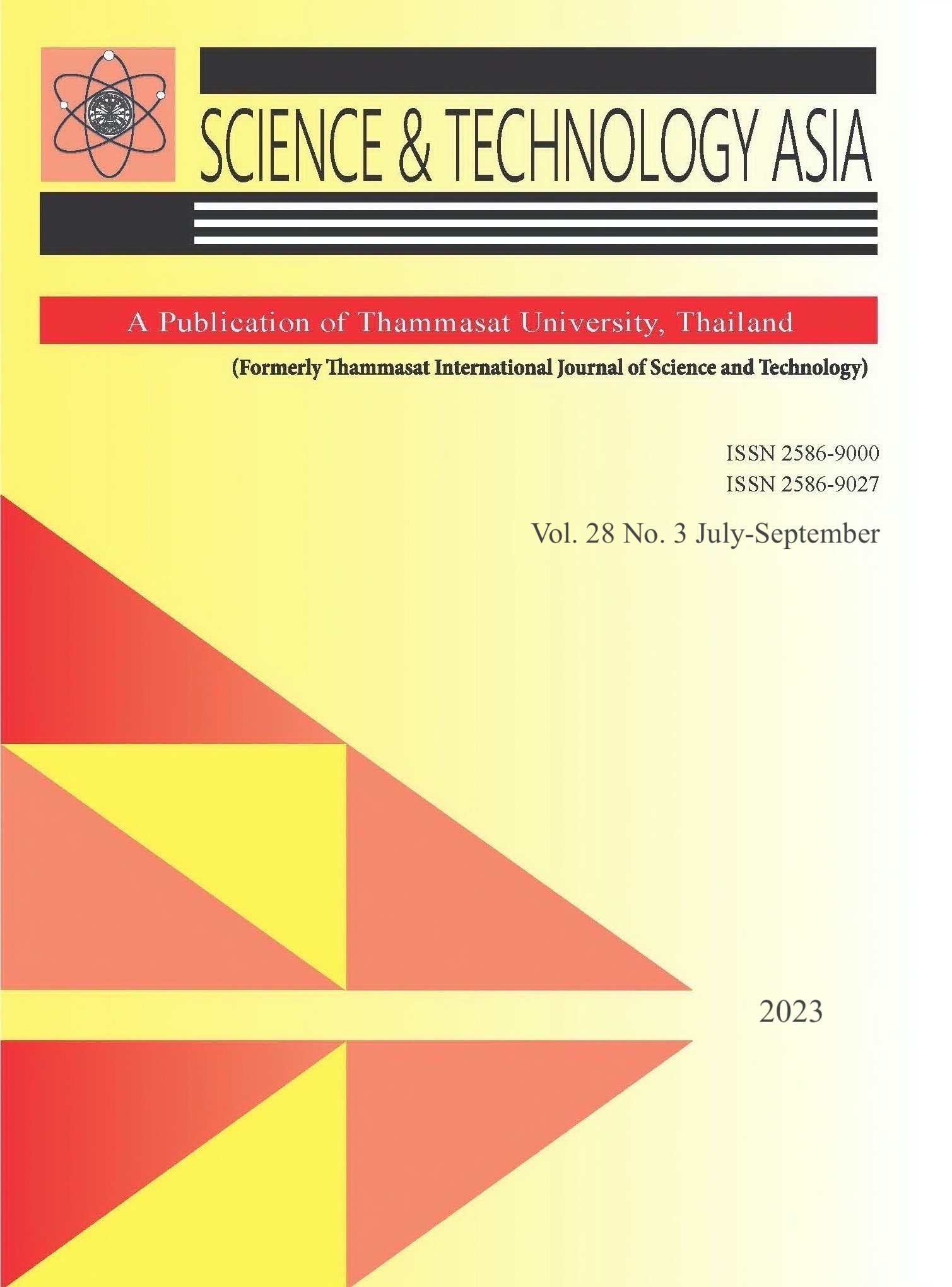Investigation of the Performance of Centrifugal Floating Feeder Machine at Different Distribution Angles
Main Article Content
Abstract
An increase in shrimp and lobster farming activities due to export required improvement in the aquacultural farming sector of Kalasin Province, Thailand. A prototype centrifugal floating food feeder machine was designed and constructed to be used on shrimp and lobster farms in Kalasin Province. The feeder was located in the center of a radially placed paper sheet. The main parameter investigated was the distribution angle that can be adjusted inside the feeder. The distribution angle significantly influences the peak density location of food drop and also the maximum density. The peak density location shifted from 6 meters to 12 meters as the distribution angle of the feeder increased from 0o to 10o. As the distribution angle inclined further to 30o and 40o the peak distribution location increased also to 14 meters. Maximum density increased from 1.787 mg/cm2 to 2.365 mg/cm2 as the distribution angle changed from 0o to 10o. However, the maximum density decreased to 1.804 mg/cm2 as the distribution angle increased to 40o. The coefficient of variation and uniformity coefficient ranged from 55.8% to 67.5% and 52.6% to 38.0% at different distribution angles. Statistical analysis through ANOVA demonstrated insignificant differences between data obtained from different distance levels and distribution angles. To provide an advance and a long-range feeding cycle with high uniformity the distribution angle should be set at 30o. The economic analysis revealed the fixed cost of 60,000 baht and labor cost of 20,000 baht giving a payback period of 8 months.
Article Details

This work is licensed under a Creative Commons Attribution-NonCommercial-NoDerivatives 4.0 International License.
References
Elwin, A;Jintana V;Feola G. Characterizing shrimp-farm production intensity in Thailand: Beyond technical indices. Ocean & Coastal Management. 2020,185,105019.
Joshi, J;Srisala J;Truong VH;Chen IT;Nuangsaeng B;Suthienkul O, et al. Variation in Vibrio parahaemolyticus isolates from a single Thai shrimp farm experiencing an outbreak of acute hepatopancreatic necrosis disease (AHPND). Aquaculture. 2014,428-429,297-302.
Kanjan, A. Improving efficiency of automatic food feeder system: King Mongkut's University of Technology Thonburi; 2020.
Ullman, C;Rhodes M;Hanson T;Cline D;Davis DA. Effects of Four Different Feeding Techniques on the Pond Culture of Pacific White Shrimp, Litopenaeus vannamei. Journal of the World Aquaculture Society. 2019,50,54-64.
Kon, K;Kawakubo N;Aoki J-I;Tongnunui P;Hayashizaki K-I;Kurokura H. Effect of shrimp farming organic waste on food availability for deposit feeder crabs in a mangrove estuary, based on stable isotope analysis. Fisheries Science. 2009,75,715-22.
Novianda, N;Liza F;Ahmad I. Intelligent System of Automatic Shrimp Feeding. IOP Conference Series: Materials Science and Engineering. 2020,854,012046.
Arditya, I;Setyastuti T;Islamudin F;Dinata I. Design of Automatic Feeder for Shrimp Farming Based on Internet of Things Technology. International Journal of Mechanical Engineering Technologies and Applications. 2021,2,145.
Mohammadidust, M;Tabibi A;Mohseni L;Jahedi A;Hekmatpour F. The effect of automatic and manual feeding method on growth and survival indices of western white shrimp. Utilization and Cultivation of Aquatics. 2021,10,43-9.
El Shal, AM;El Sheikh FM;Elsbaay AM. Design and Fabrication of an Automatic Fish Feeder Prototype Suits Tilapia Tanks. Fishes [Internet]. 2021; 6(4).
Jadali, N;Zhang MJ;Schulz AK;Meyerchick J;Hu DL. ForageFeeder: A low-cost open source feeder for randomly distributing food. HardwareX. 2023,14,e00405.
Noor, MZH;Hussian AK;Saaid MF;Ali MSAM;Zolkapli M, editors. The design and development of automatic fish feeder system using PIC microcontroller. 2012 IEEE Control and System Graduate Research Colloquium; 2012 16-17 July 2012.
Darodes de Tailly, J-B;Keitel J;Owen MAG;Alcaraz-Calero JM;Alexander ME;Sloman KA. Monitoring methods of feeding behaviour to answer key questions in penaeid shrimp feeding. Reviews in Aquaculture. 2021,13,1828-43.
Reis, J;Hussain AS;Weldon A;Walsh S;Stites W;Rhodes M, et al. Passive acoustic feeders as a tool to assess feed response and growth in shrimp pond production. Aquaculture International. 2023.
Stergiou, T;Baxevanakis KP;Roy A;Voronov LV;Sazhenkov N;Sh. Nikhamkin M, et al. Mechanics of ballistic impact with non-axisymmetric projectiles on thin aluminium targets. Part I: Failure mechanisms. Engineering Failure Analysis. 2023,107152.
Siddesh Kumar, NM;Sadashiva M;Monica J;Praveen Kumar S. Investigation on Corrosion Behaviour of Hybrid Aluminium Metal Matrix Composite Welded by Friction Stir Welding. Materials Today: Proceedings. 2022,52,2339-44.
Shi, M;Wang Q;Li G;Zhou R;Liu Y;Gao S. A new analytical method for modelling of a spherical reluctance motor based on a small amount of measured flux linkage. Measurement. 2023,208,112447.


